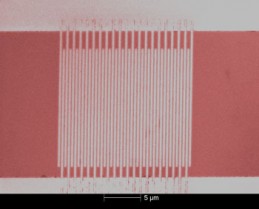Change in material boosts prospects of ultrafast single-photon detector
July 3, 2011

Researchers use electron beam lithography to pattern the nanowires (vertical lines) on a thin film of highly sensitive tungsten-silicon alloy (credit: Baek/NIST)
A practical way to boost the efficiency of the world’s fastest single-photon detector, while extending light sensitivity to longer wavelengths, has been found by researchers at the National Institute of Standards and Technology (NIST).
The detector, made of superconducting nanowires, can register individual photons. NIST’s new tungsten-silicon alloy version has an efficiency of 19 to 40 percent over a broad near-infrared wavelength range of 1280 to 1650 nanometers, including bands used in telecommunications.
The researchers selected the tungsten-silicon alloy mainly because it has higher energy sensitivity, resulting in more reliable signals.
The new tungsten-silicon alloy could make the ultrafast detectors more practical for use in quantum communications and computing systems and emerging applications such as remote sensing. An intriguing application may be an experiment to test quantum mechanics — the “loophole-free Bell test” of what Einstein called “spooky action at a distance” depends critically on having a nearly 100-percent-efficient photon detector.
Ref.: Sae Woo Nam, et al., Superconducting a-WxSi1−x nanowire single-photon detector with saturated internal quantum efficiency from visible to 1850 nm, Applied Physics Letters, 2011; 98 (25): 251105 [DOI: 10.1063/1.3600793]